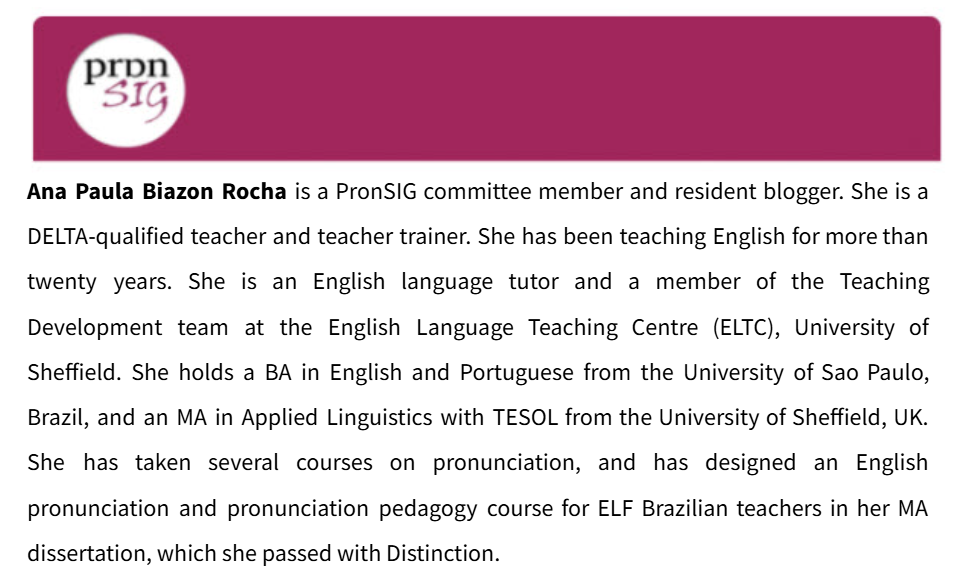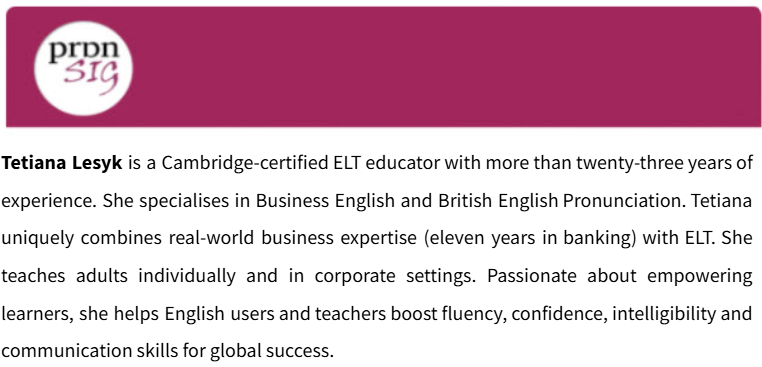by Ana P Biazon Rocha and Tetiana Lesyk
Back on 21 June 2025, Tetiana Lesyk delivered a PronSIG webinar titled ‘Sound Business: integrating pronunciation into Business English for real-world impact’. Lesyk, an English language educator from Ukraine, has vast experience in teaching Business English, drawing on her background as a former banker. Her webinar was extremely informative and well-received, sparking valuable conversations around the role of pronunciation in business communication. Inspired by its success, I invited Lesyk to co-write this blog post with me. Together, we will explore practical strategies for integrating pronunciation into Business English classes, an area that continues to offer great opportunities for meaningful learning.
1. What’s the goal of Business English learning in relation to pronunciation?
Business English learners are usually interested in improving their speaking skills to become effective communicators (Hughes & McLarty, 2016). In fact, clear, confident spoken communication is essential for participating in meetings, giving presentations, negotiating deals and building strong professional relationships in international business contexts.
According to Underhill (cited in Hughes & McLarty, 2016, p. 119), the goal of Business English learning should be comfortable intelligibility, both in speaking and listening. This means that there is not a single ‘correct’ way to pronounce words, but rather varying degrees of clarity in communication. When learning a new language, focusing solely on grammar and vocabulary is not enough; how something is said and understood is just as important. Thus, pronunciation is a core part of communication and can, and should, be practised alongside all other skills. The key is to integrate it intentionally and consistently across all classroom activities.
Similarly, in her webinar, Lesyk highlighted four main reasons why pronunciation matters in Business English:
- it shapes clarity of communication;
- it influences learners’ inner and outer confidence;
- it affects learners’ credibility and professionalism as seen by others;
- It is the missing link that learners do not realise they need.
In this sense, integrating pronunciation into Business English teaching is not just beneficial but essential for helping learners achieve their communication goals and succeed in real-world professional settings.
2. Which pronunciation features should be prioritised in Business English classes?
Lesyk listed some key pronunciation features that should be integrated into Business English lessons, such as:
a. sentence stress and chunking to ensure intelligibility and comprehensibility. For example: when practising a phrase such as ‘Let’s schedule a meeting to review the quarterly report’, learners can be guided to stress the key content words, schedule, meeting, review, report, and group them into natural chunks, such as:
Let’s schedule a meeting // to review // the report
This helps listeners process information more easily and makes the speaker sound more fluent and confident.
b. consonant contrasts, such as /v/ and /w/, to avoid misunderstandings. Learners can be guided to reflect on the consequences of mispronouncing ‘vice’ as ‘wise’ in a sentence such as ‘Please welcome our Wise President, Mr. Roberts’. This could unintentionally come across as flattery, sarcasm, or simply confuse listeners, showing how a small pronunciation slip can shift meaning and affect professional credibility.
c. intonation for professionalism, diplomacy and impact. For example, compare the following:
↘Would you consider a different pricing model. (falling intonation)
↗ Would you consider a different pricing model? (rising intonation)
Using falling intonation in this context may sound abrupt or overly direct, which can come across as pushy or even dismissive. In contrast, rising intonation indicates openness and politeness, making the question sound more diplomatic, an essential quality in business communication.
d. rhythm and weak forms in online meetings or phone calls, to help learners prepare for understanding fast, connected speech. For example, a common phrase such as ‘Can you send it to me by Friday?’ is frequently pronounced as /kən jə sɛnd ɪt tə miː baɪ ˈfraɪdeɪ/, with the weak forms of the function words (above in bold) ‘can’, ‘you’ and ‘to’. This can make the sentence sound much faster and less clear to learners. By training them to notice and practise these weak forms, you can help them improve their listening skills in real-time business interactions, where speakers rarely articulate every word clearly.
e. global intelligibility. As mentioned before, in Business English classes, you should aim for clear, flexible pronunciation that works globally because learners often interact with clients, colleagues and partners from a wide range of linguistic and cultural backgrounds. The goal is not to imitate a native-speaker accent, but to develop a pronunciation that is easy for diverse international listeners to understand, regardless of their own first language or accent.
If your learners are personally motivated to develop a standard-like accent, such as one from North America or the UK, you should certainly support them in that goal. At the same time, it is important to raise their awareness that accent alone is not the key to intelligibility or effective communication. Clarity, rhythm and listener-friendly speech are much more relevant in global contexts.
3. How to integrate pronunciation meaningfully
Integrating pronunciation meaningfully into Business English requires more than occasional drills or isolated correction. It calls for strategic attention to how professionals actually use English – when they present, negotiate, build rapport, or respond under pressure. In the webinar, Lesyk underscored that pronunciation must be treated as a performance skill, not a linguistic afterthought.
One effective approach is to use real-life speaking events – pitches, voice notes, or video calls – as learning material. This allows learners to hear their own voices in action and observe how rhythm, intonation, or mispronounced sounds influence meaning and presence. Another suitable way is to work with impactful, authentic language used by public figures, business leaders, or even the learners themselves, and to show how their delivery reinforces or undermines their message. With business learners, pronunciation should be explored not only for accuracy, but for effect – how the sound of speech supports credibility, clarity, and persuasive power.
To get a better understanding of how intonation patterns influence the perceived strength, confidence, or credibility of a message in professional contexts, here is a suggested practical activity about analysing intonation in persuasion:
1. Set the context: Assign each learner a personalised business-relevant task – for example, delivering a short product pitch, introducing a presentation, or responding to a negotiation request with a polite refusal.
2. Define communicative intent: Before delivery, ask learners to consider the intended effect of their message. Clarify the tone required for each task, e.g.:
- A persuasive pitch: confident tone, falling intonation, finality on key points.
- An uncertain or unconvincing proposal: hesitant tone, rising or flat intonation, weaker emphasis.
- A firm refusal: decisive tone, controlled falling intonation, stressed content words.
3. Performance and analysis: Learners perform their spoken tasks either in pairs or for the whole group. Listeners identify and interpret the speaker’s intonation patterns, discuss whether the delivery aligned with the intended message, and predict the likely communicative outcome (e.g. Did the pitch sound convincing? Did the refusal come across as polite yet firm?)
4. Optional recording: Record learners’ performances (with consent) for playback and further analysis. This can be done individually or as a follow-up group reflection.
5. Refinement and transformation: As an extension, ask learners to redeliver the same message but with the opposite intended effect. For instance, turn a confident pitch into an unsure one, or soften a firm refusal into a tentative suggestion. This helps learners explore how shifts in intonation alone can alter the reception of their message, regardless of the actual words used.
This activity builds learners’ capacity to manipulate intonation deliberately and flexibly based on communicative goals. It also enhances their critical listening skills and promotes peer feedback in a structured, outcome-oriented way.
In conclusion, pronunciation in Business English is no longer a ‘nice-to-have’ but a critical element of professional identity. In high-impact business settings where trust is built in seconds and impressions matter, how something is said often speaks louder than what is said. This work is not about eliminating accents or striving for native-like speech, but about being understood clearly and confidently in contexts where communication must be effective, efficient, and impactful. Integrating pronunciation into Business English does not mean adding more content to an already packed syllabus but working smarter with what is already there. Focusing on intelligibility allows learners to fine-tune rhythm, stress, and intonation to structure information and convey intent, giving them greater control over tone, clarity, and delivery. When pronunciation is approached not as correction but as empowerment, it becomes a transferable skill that helps learners move from simply participating in English to leading in it, inside and beyond the classroom.
If you are a PronSIG member, don’t forget to check the recording of Lesyk’s webinar on the resources page on the IATEFL.org website. If you are not a member yet, no time like the present. Join us!
For more discussions, ideas and tips on how to teach pronunciation, please check our previous blog posts here. Don’t forget to leave your comments below and follow PronSIG on social media.
References
Hughes, J. & McLarty, R. (2016). ETpedia Business English: 500 Ideas for Business English Teachers. Pavilion ELT.



